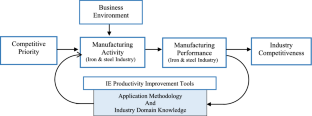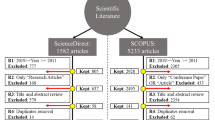Abstract
Integrated steelmaking operations, from ironmaking to final steel categories/forms, are a complex industrial system. Decision-makers, in addition to the domain knowledge, need to understand many facets related to operations management, process execution, involved risk factors and material handling aspects, etc. The solution approach must address trade-offs, uncertainties, multiple stages, multiple objectives, many decision variables, and constraints. Literature has presented several Industrial Engineering approaches like multi-objective optimisation, heuristics, evolutionary algorithm, Simulations, lean six-sigma, etc., to address the iron and steel industry's complex problems like integrated production planning. The manuscript reviews recent application of these IE tools/solution approaches in iron and steel industries to enhanced productivity/competitiveness. A Systematic Literature Review (SLR) methodology has been adopted. The review will help the practitioners and academicians to know the different problem areas about iron and steel industries discussed in the literature, and the solution approaches used to solve the problem.






Similar content being viewed by others
References
IISE Body of Knowledge, available at https://www.iise.org/details.aspx?id=43631, visited in October 2020.
IISE Management Engineering, Industrial and Systems Engineering, available at https://www.iise.org/SHS/details.aspx?id=18280, visited October 2020.
Steel sector achievement report, (2017). Department of Industrial Policy and Promotion, Ministry of Steel, available at https://drive.google.com/file/d/0B-Tv7_upCKANLVp6N0N3czhYa00/view, visited in October 2020.
Steel industry in China - statistics and facts, 2020, available at https://www.statista.com/topics/5695/steel-industry-in-china/, visited in October 2020.
Benjamin Bartholomew, (2019). THE STEEL INDUSTRY AND ITS PLACE IN THE AMERICAN ECONOMY, AUGUST 2019 available at, https://www.bdo.com/insights/business-financial-advisory/valuation-business-analytics/the-steel-industry-and-its-place-in-the-american-e, visited in October 2020.
KAWASAKI STEEL 21st Century Foundation, Introduction of Iron and steel Processing. http://www.jfe-21st-cf.or.jp/index2.html. visited January 2021.
Editorial, (2019). The Emergence of Digital Platforms: A Conceptual Platform Architecture and impact on Industrial Engineering, Computers & Industrial Engineering, 136:546-555.
Thomé AMT, Scavarda LF & Scavarda AJ, (2016). Conducting systematic literature review in operations management, Production Planning & Control, 27:408-420.
Garza-Reyes JA, Al-Balushi M, Antony J, and Kumar V, (2016). A Lean Six Sigma framework for the reduction of ship loading commercial time in the iron ore pelletising industry, Production Planning & Control, 27: 1092-1111.
Li F, Chen ZL, and Tang L, (2017). Integrated Production, Inventory and Delivery Problems: Complexity and Algorithms, INFORMS Journal on Computing, 29: 232-250.
Dutta G, Fourer R, (2001). A Survey of Mathematical Programming Applications in Integrated Steel Plants, Manufacturing & Service Operations Management, 3:387-400.
Zhang T, Zheng QP, Fang Y, and Zhang Y, (2015). Multi-level inventory matching and order planning under the hybrid Make-To-Order/Make-To-Stock production environment for steel plants via Particle Swarm Optimization, Computers & Industrial Engineering, 87: 238-249.
Lin J, Liu M, Hao J, and Jiang S, (2016). A multi-objective optimisation approach for integrated production planning under interval uncertainties in the steel industry, Computers & Operations Research, 72:189-203.
Dong Y, and Zhao R, (2018). Solve train stowage planning problem of steel coil using a pointer-based discrete differential evolution, International Journal of Production Research, 56:6937-6955.
Dong Y, and Zhao R, (2019). Solving steel coil ship stowage-planning problem using hybrid differential evolution, International Journal of Production Research, 57: 5767 -5786.
Dong Y, Zhao R, Xu W, Yang M, and Jiang W, (2020). Integrated optimisation of consolidation and stowage planning of steel coil ships using differential evolution, International Journal of Production Research, https://doi.org/10.1080/00207543.2020.1722323.
Tan Y, Zhou M, Wang Y, Guo X, and Qi L, (2019). A Hybrid MIP–CP Approach to Multistage Scheduling Problem in Continuous Casting and Hot-Rolling Processes, IEEE Transactions on Automation Science and Engineering, 16:1860-1869.
Guo Q, and Tang L, (2019). Modelling and discrete differential evolution algorithm for order rescheduling problem in steel industry, Computers & Industrial Engineering, 130:586-596.
Pan QK, (2016). An effective co-evolutionary artificial bee colony algorithm for steelmaking-continuous casting scheduling, European Journal of Operational Research, 250:702-714.
Mao K, Pan QK, Chai T, and Luh PB, (2015). An Effective Subgradient Method for Scheduling a Steelmaking-Continuous Casting Process, IEEE Transactions on Automation Science and Engineering, 12:1140-1152.
Li C, Qin J, Li J, and Hou Q, (2016). The accident early warning system for iron and steel enterprises based on combination weighting and Grey Prediction Model GM (1, 1), Safety Science, 89:19-27.
Long J, Zheng Z, Gao X, and Pardalos PM, (2016). A hybrid multi-objective evolutionary algorithm based on NSGA-II for practical scheduling with release times in steel plants, Journal of the Operational Research Society, 67:1184–1199.
Zheng Z, Long JY, and Gao XQ, (2017). Production scheduling problems of steelmaking-continuous casting process in dynamic production environment, Journal of Iron and Steel Research International, 24:586-594.
Hao J, Liu M, Jiang S, and Wu C, (2015). A soft-decision based two-layered scheduling approach for uncertain steelmaking-continuous casting process, European Journal of Operational Research, 244:966-979.
Kano M, Nakagawa Y, (2008). Data-based process monitoring, process control, and quality improvement: Recent developments and applications in steel industry, Computers and Chemical Engineering, 32:12-24.
Prinz K, Steinboeck A, Müller M, Ettl A, Schausberger F, and Kugi A, (2019). Online Parameter Estimation for Adaptive Feedforward Control of the Strip Thickness in a Hot Strip Rolling Mill, Journal of Manufacturing Science and Engineering, 141:071005. https://doi.org/https://doi.org/10.1115/1.4043575.
Shahin A, Labib A, Emami S, and Karbasian M, (2019). Improving Decision-Making Grid based on interdependence among failures with a case study in the steel industry, The TQM Journal, 31:167-182.
Mohanty I, Sarkar S, Jha B, Das S & Kumar R, (2014). Online mechanical property prediction system for hot rolled IF steel, Ironmaking & Steelmaking, 41(8):618-627, https://doi.org/10.1179/1743281214Y.0000000178.
Jena N, Seth N, (2016). Factors influencing logistics cost and service quality: a survey within the Indian steel sector, Industrial and Commercial Training, 48:199-207. https://doi.org/10.1108/ICT-09-2015-0057.
Ge P, Meng Y, Liu J, Tang L, and Zhao R, (2020). Logistics optimisation of slab pre-marshalling problem in steel industry, International Journal of Production Research, 58: 4050-4070.
Nordlöf H, Wiitavaara B, Winblad U, Wijk K, and Westerling R, (2015). Safety culture and reasons for risk-taking at a large steel-manufacturing company: Investigating the worker perspective, Safety Science, 73:126-135.
Koivupalo M, Sulasalmi M, Rodrigo P, and Väyrynen S, (2015). Health and safety management in a changing organisation: Case study global steel company, Safety Science, 74:28-139.
International Labour Organization, 2005, https://www.ilo.org/global/publications/books/WCMS_081882/lang--en/index.htm.(visited February 2021)
National Security Council (NSC), 1947. Milestones: 1945–1952 - Office of the Historian (state.gov).
Nazaripour E, Halvani G, Jahangiri M, Fallahzadeh H, and Mohammadzadeh M, (2018). Safety performance evaluation in a steel industry: A short-term time series approach, Safety Science, 110:285-290.
Waters T, Putz-Anderson V, Garg A, Fine L, (1993). Revised NIOSH equation for the design and evaluation of manual lifting tasks. Ergonomics, 36:749-776.
Hignett S and McAtamney L, (2000). Rapid Entire Body Assessment (REBA). Applied Ergonomics, 31:201-205. https://doi.org/10.1016/S0003-6870(99)00039-3.
McAtamney L and Corlett NE, (1993). RULA: a survey method for the investigation of work-related upper limb disorders. Appl Ergon. 24:91-9. https://doi.org/10.1016/0003-6870(93)90080-s.
Liu J, An R, Xiao R, Yang Y, Wang G, and Wang Q, (2017). Implications from substance flow analysis, supply chain and supplier’ risk evaluation in iron and steel industry in Mainland China, Resources Policy, 51:272-282.
Jain N, and Singh AR, (2020). Sustainable supplier selection criteria classification for Indian iron and steel industry: a fuzzy modified Kano model approach, International Journal of Sustainable Engineering, 13:17-32.
Pena JG, de Oliveira Junior VB, and Salles JL, (2019). Optimal scheduling of a by-product gas supply system in the iron- and steel-making process under uncertainties Computers & Chemical Engineering, 125:351-364.
Mehmanpazir F, Khalili-Damghani K, and Hafezalkotob A, (2019). Modeling steel supply and demand functions using logarithmic multiple regression analysis (case study: Steel industry in Iran), Resources Policy, 63:101409.
Azimifard A, Moosavirad SH, and Ariafar S, (2018). Selecting sustainable supplier countries for Iran's steel industry at three levels by using AHP and TOPSIS methods, Resources Policy, 57:30-44.
Daoutidis, P., Lee, J.H., Harjunkoski, I., Skogestad, S., Baldea, M. and Georgakis, C. (2018). Integrating operations and control: A perspective and roadmap for future research. Computers & Chemical Engineering, 115:179-184.
Ghanbari H, Pettersson F, Saxén H, (2015). Optimal operation strategy and gas utilisation in a future integrated steel plant, Chemical Engineering Research and Design, 102:322-336.
Ravi B, (2016). SMART Foundry 2020, IEEE POTENTIALS 0278–6648/16©2016 IEEE.
Yokogawa, Industrial Automation and Test and Measurement solutions. https://www.yokogawa.com/in/library/resources/application-notes/instruments-andsolution-for-iron-steel-industry-pdf/ (visited on February 09, 2021).
SICK sensor technology, (2021) https://sickusablog.com/optimizing-manufacturing-processes-steel-industry/ (visited on February 09, 2021).
Neef C, Hirzel S, and Arens M, (2018). Industry 4.0 in the European Iron and Steel Industry: Towards an Overview of Implementations and Perspectives, Fraunhofer Institute for Systems and Innovation Research ISI Karlsruhe, Germany.
Miśkiewicz R, and Wolniak R, (2020). Practical Application of the Industry 4.0 Concept in a Steel Company, Sustainability, 12:5776, https://doi.org/10.3390/su12145776.
Casado S, Laguna M, Pacheco J, and Puche JC, (2020). Grouping products for the optimisation of production processes: A case in the steel manufacturing industry, European Journal of Operational Research, 286:190-202.
Özgür A, Uygun Y, and Hütt MT, (2020). A review of planning and scheduling methods for hot rolling mills in steel production, Computers & Industrial Engineering (in press). https://doi.org/10.1016/j.cie.2020.106606.
Fukuyama H, Liu HH, Song YY, and Yang GL, (2021). Measuring the capacity utilisation of the 48 largest iron and steel enterprises in China, European Journal of Operational Research, 288: 648-665.
Tang L, Meng Y, Chen ZL, and Liu J, (2016). Coil Batching to Improve Productivity and Energy Utilization in Steel Production, Manufacturing & Service Operations Management 18:262-279.
Lin J, Liu M, Hao J, and Gu P, (2017). Many-objective harmony search for integrated order planning in steelmaking-continuous casting-hot rolling production of multi-plants, International Journal of Production Research, 55:4003-4020.
Wang Y, Chen C, Tao Y, Wen Z, Chen B, and Zhang H, (2019). A many-objective optimisation of industrial environmental management using NSGA-III: A case of China's iron and steel industry, Applied Energy, 242:46-56.
Fanti MP, Rotunno G, Stecco G, Ukovich W, and Mininel S, (2016). An Integrated System for Production Scheduling in Steelmaking and Casting Plants, IEEE Transactions on Automation Science and Engineering, 13: 1112 - 1128.
Browne F, Chiu GT, and Jain N, (2019). A Nonlinear Dynamic Switched-Mode Model of Twin-Roll Steel Strip Casting, Journal of Dynamic Systems, Measurement, and Control, 141: 081004 (10 pages).
Zhao XC, Bai H, Lu X, Shi Q, and Han J, (2015). A MILP model concerning the optimisation of penalty factors for the short-term distribution of byproduct gases produced in the iron and steel making process. Applied Energy, 148:142-158.
Maddaloni A, Porzio GF, Nastasi G, Colla V, and Branca TA, (2015). Multi-objective optimisation applied to retrofit analysis: A case study for the iron and steel industry, Applied Thermal Engineering, 91:638-646.
Mele M, and Magazzino C, (2020). A Machine Learning analysis of the relationship among iron and steel industries, air pollution, and economic growth in China, Journal of Cleaner Production, 277:123293. https://doi.org/10.1016/j.jclepro.2020.123293.
Nielsen H, (2017). Productive efficiency in the iron and steel sector under state planning: The case of China and former Czechoslovakia in a comparative perspective, Applied Energy, 185: 1732-1743.
Author information
Authors and Affiliations
Corresponding author
Additional information
Publisher's Note
Springer Nature remains neutral with regard to jurisdictional claims in published maps and institutional affiliations.
Rights and permissions
About this article
Cite this article
Akarte, M., Khanzode, V., Iqbal, R. et al. IE Tools for Boosting Competitiveness in Iron and Steel Industry: A Review. Trans Indian Inst Met 74, 1065–1076 (2021). https://doi.org/10.1007/s12666-021-02228-3
Received:
Accepted:
Published:
Issue Date:
DOI: https://doi.org/10.1007/s12666-021-02228-3




